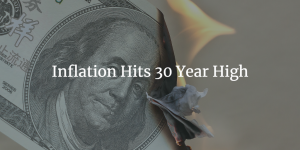Latest News
Categories
Recent Articles
NZ Inflation Highest Level in 30 Years

The Reserve Bank’s ideal target of 2% annual inflation is designed to create a Goldilocks scenario, in which the economy is running not too hot, and not too cold. The latest number – an annualised rate of 5.9% – is way beyond this.
However, most commentators, economists and fund managers were expecting a high figure. Inflationary pressure has been building in the global economy throughout the Covid-19 era and every developed economy in the world is now dealing with rising prices, for everything from food to energy to housing.
While there’s no single explanation for why the inflation numbers are so high, here are three major contributing factors.
1. Energy and Commodity prices are Soaring
Given the global economy’s continued reliance on fossil fuels, oil prices have a major impact on inflation. In March 2020, when the first wave of Covid-19 sent global markets plummeting, oil prices collapsed to around US$20 per barrel. Since then, prices have headed in one direction, hitting almost US$100 per barrel as economies around the world reopen and expand. Tensions in Ukraine have sped up the rise, with oil looking like it could head well above US$100 if there is conflict. It’s a similar story for other key fuels such as natural gas, heating oil and coal.
The global reopening, coupled with government infrastructure spending, has also put pressure on commodity prices. This is across the board, from construction materials (a big factor in New Zealand’s inflation numbers) to the metals needed to build the clean energy economy of the future, such as copper, aluminium, nickel and lithium.
In the face of this increased demand, the available supply for many commodities is constrained. Some of this is because of a lack of investment in new capacity over the last 10 to 15 years, because prices have been low. Creating new supply typically takes several years, which suggests that commodity prices aren’t going to return to pre-Covid levels in a hurry.
As the costs of energy and raw materials go up, we end up paying more for everything – whether that’s a new phone, or building materials, or the weekly groceries.
2. Global supply chains are a mess
Not only are commodities in short supply but getting them to their destination – and all the other things we import and export – has become difficult, slow and expensive.
Omicron has also affected global supply chains, through significant workforce disruptions at ports and in manufacturing, logistics and freight businesses. China is still pursuing an elimination policy in the face of Omicron, locking down huge populations who play key roles in making global consumer goods. Air cargo is also still behind its pre-Covid capacity.
The more expensive it is to ship goods around the world, the more consumers end up paying for them.
3. When the US runs hot, we do too
As Covid-19 spread and sent the world into lockdown, there was no way of knowing how it would impact the global economy. As a result, governments created stimulus to keep people in jobs. This was done through different means: by cutting interest rates to near-zero; through wage subsidies that avoided mass unemployment; and through bond buyback schemes, which were essentially a way to inject fresh money into capital markets.
Because the United States is the world’s most powerful economy, the Federal Reserve’s stimulus has had a global impact. It has contributed to rising asset prices, from stock markets to housing. It has led to increased household savings and kept consumer demand for goods high. It has also enabled businesses to add cheap debt to their balance sheets. Higher spending means more economic growth, which leads to a stronger jobs market. A stronger jobs market creates a lower unemployment rate, and as worker shortages begin to emerge, wages go up – another strong inflationary pressure.
In January, the US Consumer Price Index hit an annualised rate of 7.5% – the highest rate in 40 years. With prices running this hot, The Fed is going to have to take action. And where The Fed goes, other reserve banks – including our own – tend to follow.
In the second half of 2021, there were debates about whether inflation would be transitory – a short-lived spike caused by the Covid-19 shock. In the first half of 2022, its looking like inflation is stubbornly here; a sign of an overheating global economy. The response from The Fed and other central banks will be to dial back stimulus, particularly in financial markets, and to increase interest rates. The goal will be to reduce the cheap money supply, rein in spending and take some of the air out of the inflation balloon before it truly gets out of control.

Mark Jones, Hallam Jones
Want to find out more? Simply give Mark Jones a call on 0800 404 202 or send him a message.
This content has been provided for information purposes only and is not intended as a substitute for specific professional advice on investments, financial planning or any other matter. Read our disclaimer notice and privacy statement.





